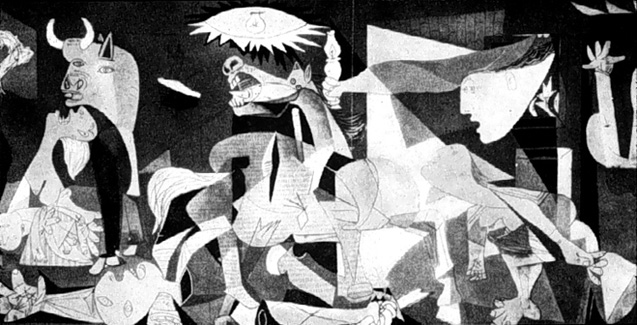Many tend to believe art is separate from science, a retreat from the rational for the purpose of entertainment, but this is not true. Art, of any and every variety, follows an inner logic which, if not respected, will cause the artwork to limp instead of dance. Symmetry and precision can be measured objectively and dictate much of what is considered pleasing or “beautiful” in a piece. But is this art’s highest aim? Or can and should art generate a wholly different type of response? If art should stay beautiful then what should be done with the Whitmans and Picassos of the world? Walt Whitman, whose untamable free verse delivered writers the world over from the ironclad shackles of tradition, and Pablo Picasso, the Spanish powerhouse, absorbed the world, scrambled it and placed it, in all its hideous splendor, on canvases for the world to see. These two artists took the safety of their respective mediums and purposefully altered their natural balance and properness inherited from past generations in order to create an experience that is uneasy, perhaps even ugly, but consistently uplifting.
In his time, Whitman’s sizeable achievements were eclipsed by the work of his more popular contemporaries. While Edgar Allan Poe terrified his readers with gothic tales filled with menacing characters and cryptic landscapes, critics were labeling Whitman’s poetry as “barbaric.” The similarly bearded Henry Wadsworth Longfellow elevated his many stanzas to the epic heights of the mountains he wrote about, but Whitman kept his work on the ground, gearing every word toward the common, working-class man. Whitman wrote so the very people he celebrated could understand what was being written.
Much like Whitman’s disregard for the refinement of his era, Picasso simultaneously absorbed and  rejected the techniques of the past. Even in his formative years, his control of the brush and sense of the surreal was apparent. Instead of studying during math class he would doodle, turning sevens into upside down noses. In the years that followed, Picasso would prove that art did not have to be beautiful in order to be powerful, sometimes both eyes would be placed on the same side of a subject’s head, or several fragments of a painting would collide or clash creating a “collage” effect (cubism). In his boldest political statement, and arguably one of his overall finest expressions artistically, Picasso broadcasts his outrage at recent violence in Spain through “Guernica.” A black and white painting, the barely human figures overlap, producing a sense of immediate chaos. Their mouths are open; they’re shrieking, faces filled with agony. A mother is at the far left of the scene, cradling her dead child, a subtle nod to Michelangelo’s “Pieta” where the Virgin Mary is portrayed holding Jesus’ lifeless body in her arms.
rejected the techniques of the past. Even in his formative years, his control of the brush and sense of the surreal was apparent. Instead of studying during math class he would doodle, turning sevens into upside down noses. In the years that followed, Picasso would prove that art did not have to be beautiful in order to be powerful, sometimes both eyes would be placed on the same side of a subject’s head, or several fragments of a painting would collide or clash creating a “collage” effect (cubism). In his boldest political statement, and arguably one of his overall finest expressions artistically, Picasso broadcasts his outrage at recent violence in Spain through “Guernica.” A black and white painting, the barely human figures overlap, producing a sense of immediate chaos. Their mouths are open; they’re shrieking, faces filled with agony. A mother is at the far left of the scene, cradling her dead child, a subtle nod to Michelangelo’s “Pieta” where the Virgin Mary is portrayed holding Jesus’ lifeless body in her arms.
The lessons Whitman and Picasso taught are not easily digested. They are not instantly accessible or immediately gratifying. Their skills cannot be divided into slices and examined under a microscope for everyone to practice and perfect. They were two unique artisans who had a creative vision: rearrange how the world thought, talked and felt about art.


1 comment:
Your are Nice. And so is your site! Maybe you need some more pictures. Will return in the near future.
»
Post a Comment